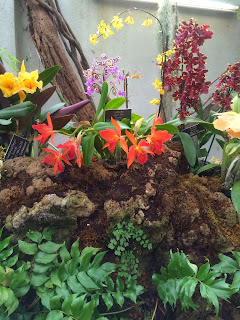February and March were cold months in Silver Spring. Coming
from Michigan, I figured that the winter weather wouldn't phase me, but Silver
Spring winds definitely rival those of southeastern Michigan. Burr! There were
also some icy days that left me chuckling as I skated in my sneakers down the
sidewalk.
Slippery sidewalks!
Snow on the hand statue in front of Building 3 of NOAA's Silver Spring campus.
On the fellowship front, things have been much warmer. I am
into the third month and loving it. Apart from writing the Great Lakes report
section of the Comprehensive
Harmful Algal Bloom and Hypoxia
Research Plan and Action Strategy (a report mandated by the 2014
reauthorization of the HABHRCA or Harmful Algal Bloom and Hypoxia Research and
Control Act), I have been helping to put on a HABHRCA webinar series to
reach out to stakeholders for their input on needs relating to HABs and
hypoxia. An additional stakeholder forum was held in person at Bowling Green
State University in Bowling Green, Ohio.
I also participated in Great Lakes Day in Washington DC, at
which the Great Lakes Commission, Healthy Waters Coalition, government
employees, and others gathered to meet with legislators on the Hill about
topics near and dear to those who care about the Great Lakes, including
nutrient pollution and Asian carp.
As part of my fellowship, I have had the opportunity to
spend some time at the Great Lakes Environmental Research Laboratory in Ann
Arbor, Michigan. It is a fun place, with hallways and conference rooms named
after places in the Great Lakes, including the St. Clair River and the Lake
Superior conference room. The people are warm and welcoming.
During one of my visits to Michigan, I took a side trip to
the Lake Michigan Field Station in Muskegon, Michigan. Marine Superintendent, Dennis Donahue, gave me
a tour of the station and vessels. Though the station doesn’t appear to be
large, it houses a number of small and mid-sized boats that are used by federal
agencies and universities for research and outreach purposes. I was impressed
to find out that the station was partially powered by solar panels and wind
turbines, and that the entire fleet runs on biodiesel! The engineers at LMFS
are masters at stripping down vessels and building them back up with updated
hardware to suit the science needs of the NOAA researchers. My favorite vessel was the 41-year-old SRV (small
research vessel) Laurentian, a boat I had heard about from my mentors at the
University of Michigan, but had never seen in person until now.
SRV Laurentian - laden with science equipment, ready for the field season.
SRV Laurentian
SRV Laurentian - the bench where samples are processed.
SRV Laurentian
We also had a Knauss event that included Knauss Alumni and
Sea Grant staff at the National Botanic Garden. We had the entire gardens to
ourselves and ample opportunity to catch up with fellows from placement week
and to meet new people. Its warmth and greenery was a nice reprieve from the
cold, windy world outside. I connected with some people whose names I had been
seeing while I did the information searches for the HABHRCA report.
Orchids at the United States Botanic Garden
Orchids at the United States Botanic Garden
The Botanic Garden was lit up at night for the Knauss Alumni event
Another exciting aspect of the fellowship is the professional
development activities. One notable event was the DC Science Writers
Association Professional Development Day. I am not a science writer per say,
but since I have a general interest in science writing and communications, I
was pleasantly surprised to find that the workshops were useful for someone at
my level, who doesn’t yet have formal science writing experience. We talked
about good versus bad story pitches and what it meant to be a good editor.
Looking forward to more fun as the fellowship continues!











No comments:
Post a Comment